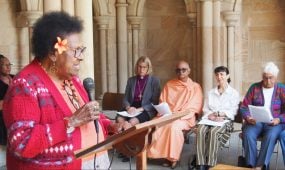Lent: a time for renewal
Reflections
Likening sin to “an arrow falling short of the target”, The Ven. Keith Dean Jones reflects upon the Lenten season’s call to be penitent and “owning up to the truth and asking God for His forgiveness”

It has been claimed that modern Australian culture is dominated by three concerns: appearance, affluence and achievement. They are superficial categories that distort perceptions of both self and others, and for most people they bring little joy. I think that we need opportunities to see more clearly, to confront our frailty and to recognise our need for God. The Lord Protector Oliver Cromwell (1599-1658) asked the court artist Sir Peter Lely “to paint me warts and all”, and Lent is an opportunity to embrace reality. It is by seeing ourselves ‘as we are’ and by seeing God ‘as He is’ that we are set free to be ourselves.
The word ‘Lent’ is Anglo-Saxon, and it refers to the season of spring. In Australia, the seasons are ‘upside down’ and if we have good imaginations the days may seem to be getting a bit cooler. The season of Lent lasts for forty days, and it represents the forty days that Jesus spent in the wilderness. The first day is Ash Wednesday, and the six Sundays of the season are ‘in Lent’, but they are not included in the reckoning of time. In the early Church, Lent was a time of preparation for baptisms at the Easter Vigil, and it was only in later centuries that penitential practices for catechumens (i.e. baptism candidates) were applied to all Christians every year.
The emphasis of Lent is our response to sin. In the New Testament, the Greek word for sin is ‘hamartia’. It is a word derived from archery, and it refers to an arrow falling short of the target. I think that we want to be loving, forgiving and Christ-like in thoughts and actions. But, the reality is that we often fall short. Penitence is owning up to the truth and asking God for His forgiveness.
Advertisement
An ancient tradition of the Church is that the earliest of the four Gospels, the Gospel according to Mark, is based on the sermons preached in the early Roman Church by Peter. Eusebius of Caesarea refers to a statement of Papias, Bishop of Hierapolis (c.60-163): “Mark wrote down accurately as many things as he recalled from memory – though not in an ordered form – of the things said or done by our Lord (Eusebius History of the Church c.320). Although biblical scholars have criticised this tradition, there is evidence for a strong Petrine tradition in the Gospel.
In Ancient Rome, many sought to achieve ‘virtus’, which was then associated with connotations of ‘manliness’, that was achieved by worldly success. There was no room for the admission of failure. But in the Gospel according to Mark, the chief of the apostles, Peter, is not always portrayed in a good light. At Caesarea Philippi he confesses Jesus as Messiah, but when Jesus reveals that he will be rejected, suffer, die and raised to new life, Peter argues with him (Mark 8.27-33). Peter follows Jesus to the courtyard of the High Priest, but when asked if he is a follower of Jesus he denies any relationship with him (Mark 14.66-72).
Advertisement
What is true of Peter is also true of Paul. Writing in his Second Letter to the Corinthians, Paul refers to ‘a thorn in the flesh” (II Corinthians 12.7). We are not sure what Paul meant; some think that it might have been a physical ailment and others a breakdown in a relationship. Paul regards his experience as an opportunity, and he comments: ‘Three times I appealed to the Lord about this, that it would leave me, but he said to me, “My grace is sufficient for you, for power is made perfect in weakness” ’(v.8).
Unlike many of their age, both Peter and Paul were prepared to face the reality of the weakness. This is at the heart of our spirituality, and Lent is an opportunity to see ourselves as God sees us.





